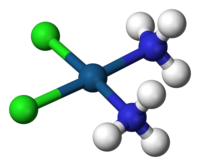
Photo from wikipedia
A comprehensive exploration of the inverse trans-influence (ITI) phenomenon in a series of cis-[UVI(O)(L)Cl4]0/- and trans-[UVI(O)(L)Cl4]0/- complexes involving a wide variety of neutral and anionic unidentate ligands L, using relativistic… Click to show full abstract
A comprehensive exploration of the inverse trans-influence (ITI) phenomenon in a series of cis-[UVI(O)(L)Cl4]0/- and trans-[UVI(O)(L)Cl4]0/- complexes involving a wide variety of neutral and anionic unidentate ligands L, using relativistic density functional theory, threw light on the still-intriguing physics of ITI, elucidated its origin, and deployed the ligands L in cis- and trans-ITI sequences (ladders). ITI is produced for the complete set of L in both series of [U(O)(L)Cl4]0/- complexes, but this is not reflected in the thermodynamic stability of the [U(O)(L)Cl4]0/- isomers. In effect the hard and strong σ-donor anionic ligands stabilize the trans isomers, but the opposite is true for the soft σ-donor/π-donor neutral and anionic ligands that stabilize the cis isomers. According to the ITI%(U-L) metrics the hard strong σ-donor anionic ligands exert stronger ITI than the soft σ-donor/π-donor neutral ones, while according to the ITI%(U-O) metrics ITI is produced only for the more stable trans-[U(O)(L)Cl4]0/- isomers involving the anionic ligands. In contrast the neutral ligands in the more stable cis-[U(O)(L)Cl4]0/- isomers produce the normal cis influence (CI). Furthermore, the more electronegative ligands produce stronger ITI. ITI%(U-O) cis- and trans-philicity ladders are also built for both series of complexes employing the isotropic σiso(SO) 17O NMR shielding constants as a sensitive metric of the ITI phenomenon. The NMR ITI%(U-O) metrics are consistent with the ITI%(U-O) ones illustrating that the isotropic 17O NMR shifts are sensitive metrics of the covalency of the multiple U-O bonding mode and, hence, of the ITI phenomenon. Interestingly the 2σ BD(U-O) natural bond orbitals play a key role in tuning the bond length and covalency of the U-O bond through the 2σ(U≡O) → 2σ*(U≡O) hyperconjugative interactions. The assessment of the magnitude of the ITI in the [UVI(O)(L)Cl4]0/- complexes and the recognition of the factors affecting ITI dispose a guide to experimentalists working in the area of uranium chemistry to develop strategies for stabilizing uranium-ligand linkages.
Journal Title: Inorganic chemistry
Year Published: 2020
Link to full text (if available)
Share on Social Media: Sign Up to like & get
recommendations!